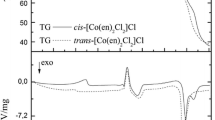Abstract
The physico-chemical properties and thermal stabilities in air of rare earth element 4-chloro-3-nitrobenzoates and 5-chloro-2-nitrobenzoates were compared and the influence of the positions of the Cl and NO2 substituents on their thermal stabilities was investigated. The complexes of both series are crystalline, hydrated or anhydrous salts with colours typical of Ln3+. The carboxylate group in these complexes is a bidentate, chelating ligand. The NO2 group in the chloronitro complexes does not undergo isomerization. The thermal stabilities of the 4-chloro-3-nitrobenzoates of Y and the lanthanides were studied in the temperature range 273-1173 K, but those of the 5-chloro-2-nitrobenzoates of these elements were studied only at 273-523 K, because they decompose explosively above 523 K. The positions of the Cl and NO2 substituents on the benzene ring influence the thermal properties of the complexes and their decomposition mechanisms. The different thermal stabilities of the complexes are connected with various inductive and mesomeric effects of the Cl and NO2 substituents on the electron density in the benzene ring.
Similar content being viewed by others
References
Bcilsteins Hanbduch der organischen Chemic, Bd. IX. Springer-Verlag, Berlin 1922.
Beilsteins Handbuch der organischen Chemie, Bd. IX. Springer-Verlag, Berlin 1921.
W. Ferenc and B. Bocian, Acta. Chim. Hung., 135 (1998) 19.
W. Ferenc and B. Bocian, J. Thermal Anal., 52 (1998) 543.
K. Nakamoto, Infrared and Raman Spectra of Inorganic and Coordination Compounds, John Wiley and Sons, Toronto 1968.
B. S. Manhas and A. K. Trikha, J. Indian Chem. Soc., LIX315 (1982) 315.
I. N. Kukuszin, Koord. Chim., 4 (1972) 1170.
D. L. M. Goodgame and M. A. Hitchman, Inorg. Chem., 6 (1967) 813.
W. W. Fee, C. S. Gamer and I. N. Harrowfield, Inorg. Chem., 6 (1967) 1.
W. Ferenc and W. Brzyska, Mh. Chem., 118 (1987) 1087.
W. Ferenc, Mh. Chem., 119 (1988) 1345.
W. Brzyska and E. Świta, J. Thermal Anal., 32 (1987) 1005.
H. A. Staab, Einführung in die theoretische organische Chemie, Springer-Verlag, Weinheim 1962.
J. Shorter, Correlation analysis in organic chemistry. An introduction to linear free-energy relationships, Clarendon Press, Oxford 1973.
D. N. Todor, Thermal Analysis of Minerals, Abacus Press, Tunbridge Wells, Kent 1976.
R. C. Mehrotra and R. Bohra, Metal Carboxylates, Academic Press, London 1983.
K. Burger, Coordination Chemistry; Experimental methods, Akadémiai Kiadó, Budapest 1973.
Author information
Authors and Affiliations
Rights and permissions
About this article
Cite this article
Ferenc, W., Bocian, B. Thermal Stability of 4-Chloro-3-Nitro- and 5-Chloro-2-Nitrobenzoates of Rare Earth Elements. Journal of Thermal Analysis and Calorimetry 55, 671–680 (1999). https://doi.org/10.1023/A:1010178826779
Issue Date:
DOI: https://doi.org/10.1023/A:1010178826779




